First All-Union Census of the Soviet Union

The First All Union Census of the Soviet Union took place in December 1926. It was an important tool in the state-building of the USSR, provided the government with important ethnographic information, and helped in the transformation from Imperial Russian society to Soviet society. The decisions made by ethnographers in determining the ethnicity (narodnost) of individuals, whether in the Asiatic or European parts of the former Russian Empire, through the drawing up of the "List of Ethnicities of the USSR", and how borders were drawn in mixed areas had a significant influence on Soviet policies. Ethnographers, statisticians, and linguists were drawing up questionnaires and list of ethnicities for the census. However, they also had the more ambitious goal of deliberately transforming their identities according to the principles of Marxism-Leninism. As Anastas Mikoyan put it, the Soviet Union was: "creating and organising new nations".[1]
Previous censuses
The First All Union Census of the Soviet Union followed two partial censuses carried out by the Bolsheviks following their seizure of power in Russia. The first, the general census of 1920, took place during the Civil War and the Soviet-Polish War. It was thus unable to deal with the Crimea, much of Transcaucasia, Ukraine, Belarus, Far Eastern, Siberian, and Central Asian parts of the Soviet Union as well as with its Far Northern parts. Yet it is worth to note that there was only 15,000,000 population increase between 1920 and 1926 constituting in some 131,304,931 people according to the TIME magazine while is still undisclosed in Russian history.[2] The 1923 Census was restricted to cities. Prior to the Russian Revolution, the only Russian Empire Census was done in 1897.
Methodology
By classifying the population in terms of narodnosti (nationalities)—as opposed to tribe or clan—along with policies which gave these nations land, resources, and rights, experts and local elites were encouraged to interfere with the information collecting.
List of ethnicities
This list, called Programmy i posobiya po razrabotke Vsesoyuznoy perepisi naseleniya 1926 goda, vol. 7, Perechen i slovar narodnostey, Moscow 1927, was developed by the Central Statistical Administration of the USSR.[3]
- Russian - 77 791 124
- Ukrainian - 31 194 976
- Belarusian - 4 738 923
- Polish - 782 334
- Czech
- Slovak
- Serb
- Bulgarian - 111 296
- Latvian - 151 410
- Lithuanian - 41 463
- Latgalian
- Samogitian (Zhmud)
- German - 1 238 549
- British
- Swedish
- Dutch
- Italian
- French
- Romanian - 278 903
- Moldovan - 278 903
- Greek - 213 765
- Albanian (Arnaut)
- Jewish - 2 599 973
- Crimean Jewish
- Mountain Jewish (Dag Chufut)
- Georgian Jewish
- Bukharan Jewish (Dzhugur)
- Karaim
- Finnish
- Leningrad Finnish (Chukhon)
- Karelian
- Tavastian
- Estonian - 154 666
- Vepsian (Chud)
- Vod (Vote)
- Izhorian (Ingrian)
- Kven
- Lopar (Sami people)
- Zyrian
- Permyak
- Udmurt (Votiak)
- Besermyan
- Mari (Cheremis)
- Mordva (Moksha, Erzya, Teryukhan, Karatai)
- Magyar (Hungarian)
- Gagauz
- Chuvash - 1 117 419
- Tatar - 2 916 536
- Mishar (Meshcheriak)
- Bashkir - 713 693
- Nagaybak
- Nogai
- Gypsy
- Kalmyk
- Mongol
- Buryat
- Sart-Kalmyk
- Mansi (Vogul)
- Khanty (Ostyak)
- Selkup (Ostyak-Samoyed)
- Nenets (Samoyed)
- Yurak
- Soyot (Uriankhai)
- Barabin (Barbara Tartar)
- Bukharan (Bukharlyk)
- Chernevyy Tatar (Tubalar, Tuba-Kizhi)
- Altai (Altai-Kizhi, Mountain or White Kalmyk)
- Teleut
- Telengit (Telengut)
- Kumandin (Lebedin, Ku-Kohzi)
- Shors
- Kharagas (Tuba, Kharagaz)
- Kızıl (Kyzyl)
- Kachin
- Sagai
- Koybal
- Beltir
- Dolgan (Dolgan-Iakut)
- Yakut (Sakha, Urangkhai-Sakha) - 240 709
- Tungus (Ovenk, Murchen)
- Lamut
- Orochon
- Goldai (Nanai)
- Olchi (Mangun, Ulchi)
- Negidal (Negda, Eleke Beye)
- Orochi
- Udegei (Ude)
- Orok
- Manegir
- Samogir
- Manchurian
- Chukchi
- Koryaks
- Kamchadal (Itel'men)
- Gilyak (Nivkhi)
- Yukagir
- Chuvan
- Aleut
- Eskimo
- Enisei (Ket, Enisei Ostiak)
- Aino (Ainu, Kuchi)
- Chinese
- Korean
- Japanese
- Georgian (Kartvelian) - 1 821 184
- Ajar
- Megeli (Mingrelian)
- Laz (Chan)
- Svan (Svanetian)
- Abkhaz (Abkhazian) - 56 957
- Cherkess (Adyghe)
- Beskesek-Abaza (Abazin)
- Kabard
- Ubykh
- Chechen (Nakh, Nakhchuo)
- Ingush (Galgai, Kist)
- Batsbi (Tsova-Tish, Batswa)
- Maistvei
- Lezgin
- Tabasaran
- Agul
- Archi
- Rutul (Mykhad)
- Tsakhur
- Khinalug
- Dzhek (Dzhektsy)
- Khaput (Gaputlin,Khaputlin)
- Kryz
- Budukh (Budug)
- Udin
- Dargin
- Kubachin (Ughbug)
- Lak (Kazi-Kumukh)
- Avar (Avartsy, Khunzal)
- Andi (Andiitsy, Kwanally)
- Botlog (Buikhatli)
- Godoberi
- Karatai
- Akhvakh
- Bagulal (Kvanandin)
- Chamalal
- Tindi (Tindal, Idera)
- Didoi (Tsez)
- Kvarshi
- Kapuchin (Bezheta)
- Khunzal (Enzebi, Nakhad)
- Armenian - 1 567 568
- Hemshin
- Arab
- Aisor (Assyrian, Syriac, Chaldean)
- Kaytak (Karakaitak)
- Bosha (Karachi, Armenian Gypsy)
- Ossetian - 272 272
- Kurd
- Yazid
- Talysh
- Tat
- Persian
- Karachai
- Kumyk
- Balkar (Mountain Tartar, Malkar)
- Karakalpak
- Turk
- Ottoman Turk (Osmanli)
- Samarkand and Fergana Turk
- Turkmen - 763 940
- Kirgiz (Kyrgyz, Kara-Kirgiz)
- Karakalpak - 146 317
- Kypchak
- Kashgar
- Taranchi
- Kazakh (Kirgiz-Kazakh, Kirgiz-Kaisak) - 3 968 289
- Kurama
- Uzbek - 3 904 622
- Dungan
- Afghan
- Tajik - 978 680
- Vakhan
- Ishkashim
- Shugnan
- Yagnob
- Yazgul
- Iranian
- Jemshid
- Beludji
- Berber
- Khazara
- Hindu (Indian)
- Other Ethnicities
- Ethnicities not noted or noted inexactly
191. Foreign subjects
Population by republics
-
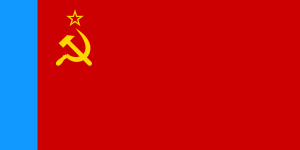 Russian SFSR - 100,891,244 (urban 17,442,655)
Russian SFSR - 100,891,244 (urban 17,442,655) -
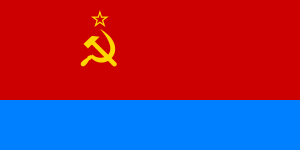 Ukrainian SSR - 29,018,187 (urban 5,373,553)
Ukrainian SSR - 29,018,187 (urban 5,373,553)
- Moldavian ASSR - 572,114
-
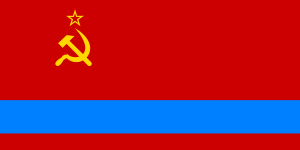 Kazakh SSR - 6,503,006 (urban 539,249)
Kazakh SSR - 6,503,006 (urban 539,249) -
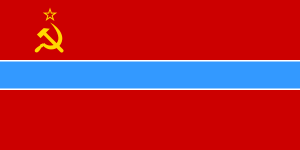 Uzbek SSR - 5,272,801 (urban 1,102,218)
Uzbek SSR - 5,272,801 (urban 1,102,218) -
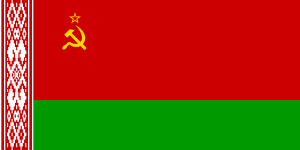 Byelorussian SSR - 4,983,240 (urban 847,830)
Byelorussian SSR - 4,983,240 (urban 847,830) -
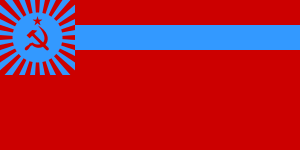 Georgian SSR - 2,666,494 (urban 594,221)
Georgian SSR - 2,666,494 (urban 594,221) -
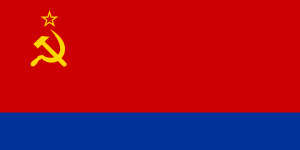 Azerbaijan SSR - 2,314,571 (urban 649,557)
Azerbaijan SSR - 2,314,571 (urban 649,557) -
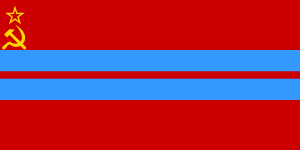 Turkmen SSR - 1,000,914 (urban 136,982)
Turkmen SSR - 1,000,914 (urban 136,982) -
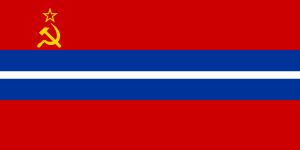 Kirghiz SSR - 993,004 (urban 121,080)
Kirghiz SSR - 993,004 (urban 121,080) -
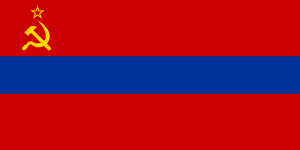 Armenian SSR - 880,464 (urban 167,098)
Armenian SSR - 880,464 (urban 167,098) -
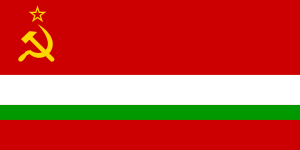 Tajik SSR - 827,200
Tajik SSR - 827,200 - Total USSR - 147,027,915 (urban 26,314,114)
References
- ↑ "Национальный вопрос и национальная култура в Северо-Кавказском крае (Итоги и перспективы): К предстоящему съезду горских народов" (Natsionalny vopros i natsionalnaya kultura v Severo-Kavkazskom kraye (Itogi i perspektivy): K predstoyashchemu syezdu gorskikh narodov), Rostov-on-Don, 1926.
- ↑ Russia:Decennial. Overview of Russian life 10 years after the revolution by the TIME magazine (English)
- ↑ Empire of Nations:Ethnographic Knowledge and the Making of the Soviet Union by Francine Hirsch, Cornell University Press, 2005, pp. 329–333
Further reading
- Henry Joachim Dubester (1948). "USSR: Census of 1926". National Censuses and Vital Statistics in Europe, 1918-1939: An Annotated Bibliography, with 1940-1948 Supplement. USA: Gale Research Company.
| ||||||||
